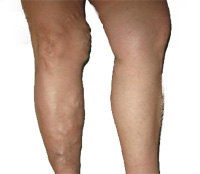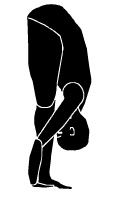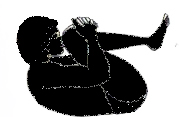Introduction

Women are more likely to have varicose veins, especially during pregnancy. In some cases, these veins may rupture and cause ulcers and blood clots. Varicose veins mostly occur on the thigh or calf, where they are close enough to the skin to be seen. However, they can occur in other parts of the body as well. Vein damage may occur due to injury, blood clot or inflammation. If there is trouble in your deep veins, you usually have pain and swelling in your leg as well. Swollen surface veins can be a symptom of damage to your deep vein. Varicose veins are a relatively common condition, and for many people they are a family trail. Women are twice as likely as men to develop them. In the United States alone, nearly 10 percent of all adult men and 20 percent of adult women are affected by them to some degree.
Yoga and Varicose Vein
Yoga is very effective in treating Varicose Veins. It helps in alleviating pain and also prevents future attack. Yoga�s stretching and relaxation techniques can be particularly beneficial for varicose veins. Certain positions, such as the Plow, Corpse, and Half Shoulder Stand, promote circulation and the drainage of blood from the legs. The deep-breathing exercises in yoga may further alleviate discomfort by getting more oxygen into the bloodstream. Yoga is an effective protocol for preventing and treating varicose veins. The posture that is known to be clinically most effective in both cases is sarvangasana, the shoulder stand (shown), where the legs are inverted and the pressure of gravity is reversed. In this pose, the blood and the lymph drain from the lower extremities back to the heart, thereby reducing the pressure of the pooled blood in the veins. Do this pose once daily. With a recommended holding time of about three to five minutes. When you stand up, movement of these fluids in the legs is greatly improved. There are many yoga breathing exercise, which can be immensely helpful in reducing varicose veins and is particularly helpful in preventing them from getting worse.YOGA POSES FOR VARICOSE VEIN
Raised Leg Pose
In this pose both the legs are raised upwards and so is called 'dwipada' (both legs) uttanpadasana.It promotes in stretching the thigh and stomach muscles. It also promoted the efficiency of stomach organs like the small intestine, enzymes producing glands and various others. The vertical position of legs helps in proper blood circulation through the legs.Cycling Pose
Pada Sanchalanasana is an Indian translation for Cycling Pose. Good for hip and knee joints and for varicose veins.Strengthens abdominal and lower back muscles. Tones up the thigh muscle and bumps off extra fat around the waist area. This pose moderates the hip elasticity among those women who has just delivered a baby.Rocking and Rolling Pose
Jhulana Ludhakana is an Indian translation for Rocking and Rolling posture. This pose is very much useful in treating varicose vein probem.Gives a good massage of entire back, buttock and hip area. Knocks out the unnecessary fats of waist area. Gives fresh feeling performing this asana in the morning after brisk walk.Spinal Twist Pose
The Spinal Twist Yoga Pose, which takes its Sanskrit name from the great Yogic Sage Matsyendra, is one of the few Yoga Poses in the Basic Session that rotates the spine. Most bend the spinal column either backward or forward, but to become truly flexible it must be twisted laterally as well. The movement also tones the spinal nerves and ligaments, and improves digestion. Keep your spine erect and your shoulders leveled in the position. Breathe steadily. Twist a little more each time you exhale.Leg Lock Pose
Pavanan means wind and Muktha means escape or relief. Pavanamukhtasana is aimed at releasing gas accumulated in abdomen and at joints. This exercise is a good treatment for gastritis and vata related pain and for varicose pain. This asana strengthens muscles of abdomen. It gives strength and flexibility to backbone and muscles at back and lower back.Boat Pose
This exercise strengthens the belly muscles, the legs and the lower back. It is also beneficial to those with kidney, thyroid, prostate and intestine problems. The Boat Pose is a great stress reliever and also improves digestion. This yoga pose is suitable for the people of all ages. It is used to increase the strength of the entire body. This posture takes its name due to the boat like shape taken by the body during this exercise.YOGA ASANAS FOR VARICOSE VEIN
SHIRSHASANA

Steps
- Sit in a kneeling position with the buttocks resting on the heels of the feet.
- Lean forward and place the forearms on the floor in front while keeping the elbows about shoulder distance apart. Interlock the fingers of both hands.
- Place the top of the head flat on the floor with the back of the head pressed against the inside of the interlocked fingers.
- Placing the tips of the toes firmly on the floor while lifting the heels, raise the knees off the floor.
- Hold for the duration of the held inhaled breath. When you can't hold the breath comfortable any longer, slowly exhale and return the back to the floor, slide the legs out straight returning to the shava-asana.
TADASANA

Steps
- Stand erect, legs together, hands by the side of the thighs. Gaze in front.
- Raise your hands straight in front up to arms. Palms facing each other.
- Bring the hands up straight fowards sky, fingers pointing upward.
- Now slowly raise your heels and stand on toes. Raise heels as much as you can.
- Stretch body up as much as possible. While returning to the original position, bring your heels on the ground first.
- Slowly bring down your hands also.
SARVANGASANA

Steps
- Lie on the back quite flat. Slowly raise the legs.
- Lift the trunk, hips, and legs quite vertically. Support the back with the two hands, one on either side. Rest the elbows on the ground. Press the chin against the chest.
- Allow the back-shoulder portion and neck to touch the ground closely. Do not allow the body to shake or move to and fro. Keep the legs straight.
- When the Asana is over, bring the legs down very, very slowly with elegance and not with any jerks.
- In this Asana the whole weight of the body is thrown on the shoulders. You really stand on the shoulders with the help and support of the elbows.
- Retain the breath as long as you can do with comfort, and slowly exhale through the nose.
MATSYASANA

Steps
- Sit with your legs fully stretched out. Bend each leg at the knees and place your feet on the other hip joint. Both the heels are adjusted in such a way that each presses the adjacent portion of the abdomen. This forms the foot-lock in a sitting position.
- Bend backwards and, exhaling, rest your weight on the elbows. Push your neck backwards and slightly rise the hip upward thus making an arch of the spine.
- Then, by making hooks of the forefingers, hold your toes on the corresponding side without crossing your arms. This posture should be maintained for some time with slow and deep breathing.
- For reverting to the original position, release the foot-lock and return to the supine position by lowering the arch.
PADAHASTASANA

Steps
- Inhale slowly, and then exhaling slowly bend forward as much as possible. Try to touch your knees, calves, ankles, or feet. Do the movement slowly and in a relaxed manner.
- Bend a little more and try to place the palms, with fingers pointing forward, on the ground on either side of the legs.
- Place the forehead between the knees. Stay in that position for 5 seconds or more time as comfortable to you.
- To release the posture, bend your knees slightly, press the soles of your feet downward and drop your tailbone, gradually bringing up the squeeze as you return to return to the original starting position.
- Repeat two to four times.
PAVANMUKTASANA

Steps
- Lie flat on the back in shava-asana.
- Inhale and raise both the legs to 45 degrees angle without bending the knees.
- Bring the legs perpendicular to the ground and complete inhalation.
- Bend the knees slowly and bring them towards the chest while exhaling. Keep both hands interlocked around the knees.
- Keep the knees and toes together.
- Raise head and bring the chin near the knees. Take small breaths in between whenever required.
- Maintain the position for 2 to 3 minutes, and then return to Shavasana position.
- Do this asana 3 to 4 times.
Diseases Related to Aquarius |
||


